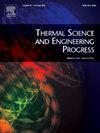红辣椒间歇微波干燥的改进:乙醇和焯水预处理对干燥行为、造型、能耗和部分品质属性的影响
IF 5.4
3区 工程技术
Q2 ENERGY & FUELS
引用次数: 0
摘要
这项研究探索了间歇性微波干燥作为太阳和热风干燥的替代方法的潜力。它还评估了乙醇浸泡(一种新的预处理方法),以及传统的热水和蒸汽焯水预处理,以提高干燥效率。研究的关键方面包括辣椒的干燥特性、水分扩散、热特性、能量消耗、造型技术、颜色变化和收缩。在80、240和400 W下进行干燥,预处理样品在240 W下干燥。在400w条件下干燥时间最短为27.5 min,在240w (240w - 100et10)条件下100%乙醇干燥时间最短为40 min。未预处理样品的最高有效水分扩散系数(Deff)和传质系数(hm)在400 W时。预处理中,240 W-100ET10的Deff和hm最高。人工神经网络建模以较高的R2和较低的RMSE优于薄层建模。热性能,包括比热和导热系数,在干燥过程中下降。240 W-100ET10的比水分蒸发速率最高,比能量消耗最低,分别为0.244 kg kWh−1和4.105 kWh kg water-1。干燥过程中L*值降低,a*和b*值变化明显。此外,高微波功率和预处理能降低厚度收缩率。主成分分析表明,热烫、蒸汽烫、400 W、%50乙醇浸10 min与240 W、80 W、240 W- 100et10具有相似性。乙醇预处理和提高微波功率是优化红辣椒间歇微波干燥工艺的可行方法。本文章由计算机程序翻译,如有差异,请以英文原文为准。
Improvement of intermittent microwave drying of red peppers: Effect of ethanol and blanching pretreatments on drying behavior, modeling, energy consumption and some quality attributes
This research explores the potential of intermittent microwave drying as an alternative to sun and hot air drying. It also evaluates ethanol immersion (a new pretreatment method), along with traditional hot water and steam blanching pretreatments, to enhance drying efficiency. Key aspects studied include drying characteristics, moisture diffusion, thermal properties, energy consumption, modeling techniques, color changes, and shrinkage in red peppers. The drying was performed at 80, 240, and 400 W, with pretreated samples dried at 240 W. The shortest drying time was 27.5 min at 400 W and 40 min with 100 % ethanol at 240 W (240 W-100ET10) for pretreatments. The highest effective moisture diffusivities (Deff) and mass transfer coefficients (hm) for unpretreated samples were at 400 W. Among pretreatments, 240 W-100ET10 had the highest Deff and hm. Artificial neural network modeling outperformed thin layer modeling with higher R2 and lower RMSE. Thermal properties, including specific heat and thermal conductivity, decreased during drying. The highest specific moisture evaporation rate and lowest specific energy consumption were 0.244 kg kWh−1 and 4.105 kWh kg water-1, respectively, for 240 W-100ET10. L* values decreased during drying, with notable changes in a* and b* values. Besides, thickness shrinkage decreased by higher microwave power and pretreatments. According to principal component analysis, hot and steam blanching and 400 W, %50 ethanol immersion for 10 min and 240 W, 80 W and 240 W-100ET10 showed similarities. Ethanol pretreatment and higher microwave power may be considered as promising methods for optimization of intermittent microwave drying of red peppers.
求助全文
通过发布文献求助,成功后即可免费获取论文全文。
去求助
来源期刊

Thermal Science and Engineering Progress
Chemical Engineering-Fluid Flow and Transfer Processes
CiteScore
7.20
自引率
10.40%
发文量
327
审稿时长
41 days
期刊介绍:
Thermal Science and Engineering Progress (TSEP) publishes original, high-quality research articles that span activities ranging from fundamental scientific research and discussion of the more controversial thermodynamic theories, to developments in thermal engineering that are in many instances examples of the way scientists and engineers are addressing the challenges facing a growing population – smart cities and global warming – maximising thermodynamic efficiencies and minimising all heat losses. It is intended that these will be of current relevance and interest to industry, academia and other practitioners. It is evident that many specialised journals in thermal and, to some extent, in fluid disciplines tend to focus on topics that can be classified as fundamental in nature, or are ‘applied’ and near-market. Thermal Science and Engineering Progress will bridge the gap between these two areas, allowing authors to make an easy choice, should they or a journal editor feel that their papers are ‘out of scope’ when considering other journals. The range of topics covered by Thermal Science and Engineering Progress addresses the rapid rate of development being made in thermal transfer processes as they affect traditional fields, and important growth in the topical research areas of aerospace, thermal biological and medical systems, electronics and nano-technologies, renewable energy systems, food production (including agriculture), and the need to minimise man-made thermal impacts on climate change. Review articles on appropriate topics for TSEP are encouraged, although until TSEP is fully established, these will be limited in number. Before submitting such articles, please contact one of the Editors, or a member of the Editorial Advisory Board with an outline of your proposal and your expertise in the area of your review.
 求助内容:
求助内容: 应助结果提醒方式:
应助结果提醒方式:


